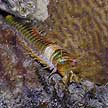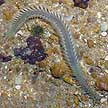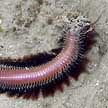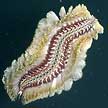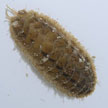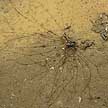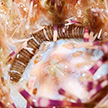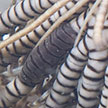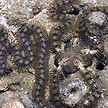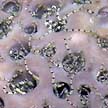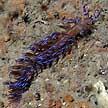 |
|
| worms text index | photo index |
|
Worms > Phylum Annelida > Class
Polychaeta
|
Typical worm-shaped with bristles*
| To 1.5m. A white ring around the fourth body segment, short pointed bristles along the body sides. Hidden in dead corals. Commonly seen on our Southern shores. | 10-20cm. Body flat, broad, tapered at both ends. Two rows of 'bunches' of bristles. Pink or green. Coral rubble, reefs, seagrasses. Commonly seen on some of our shores. | 20-30cm. Feathery appendages near the head. Usually pink or red. Sometimes seen, headless and bleeding, near seagrasses. Sometimes seen on our Northern shores. | 10cm. Body flat and broad withelaborate bristles along its sides, and a pattern of spots along the centre of the body. Swimming in water or washed ashore. Sometimes common on our Northern shores. | 1cm. Body flat and broad with bristles along its sides, and scales on the upper side. Commensal with other animals or hidden. Probably common on many shores. |
| Usually buried with only very long and very thin tentacles sticking out above the ground. Soft silty ground near seagrasses. Sometimes seen on our Northern shores. | 1-2cm. Curled around the mouth of common sea urchins. Cylindrical, banded brown and white, tiny short feet. Often seen on our Northern shores where their host urchins are common. | 1cm. Found only on feather stars, usually perfectly matching the colour and pattern of their host. Sometimes seen on our Southern shores. |
*Species are difficult to positively identify without close examination of internal parts.
On this website, they are grouped by external features for convenience of display.
These are NOT bristleworms
how to tell apart
|
|
||||
|
